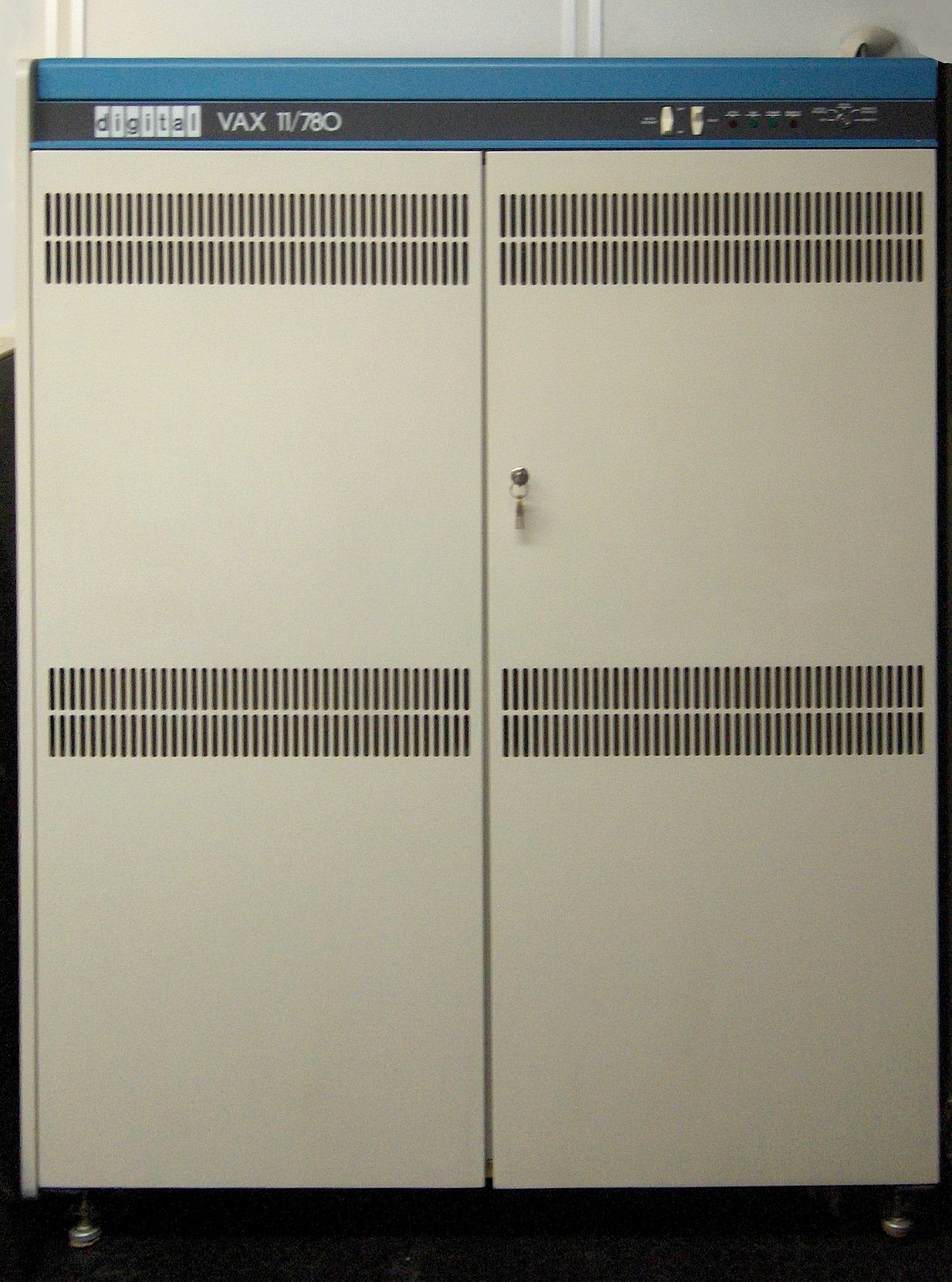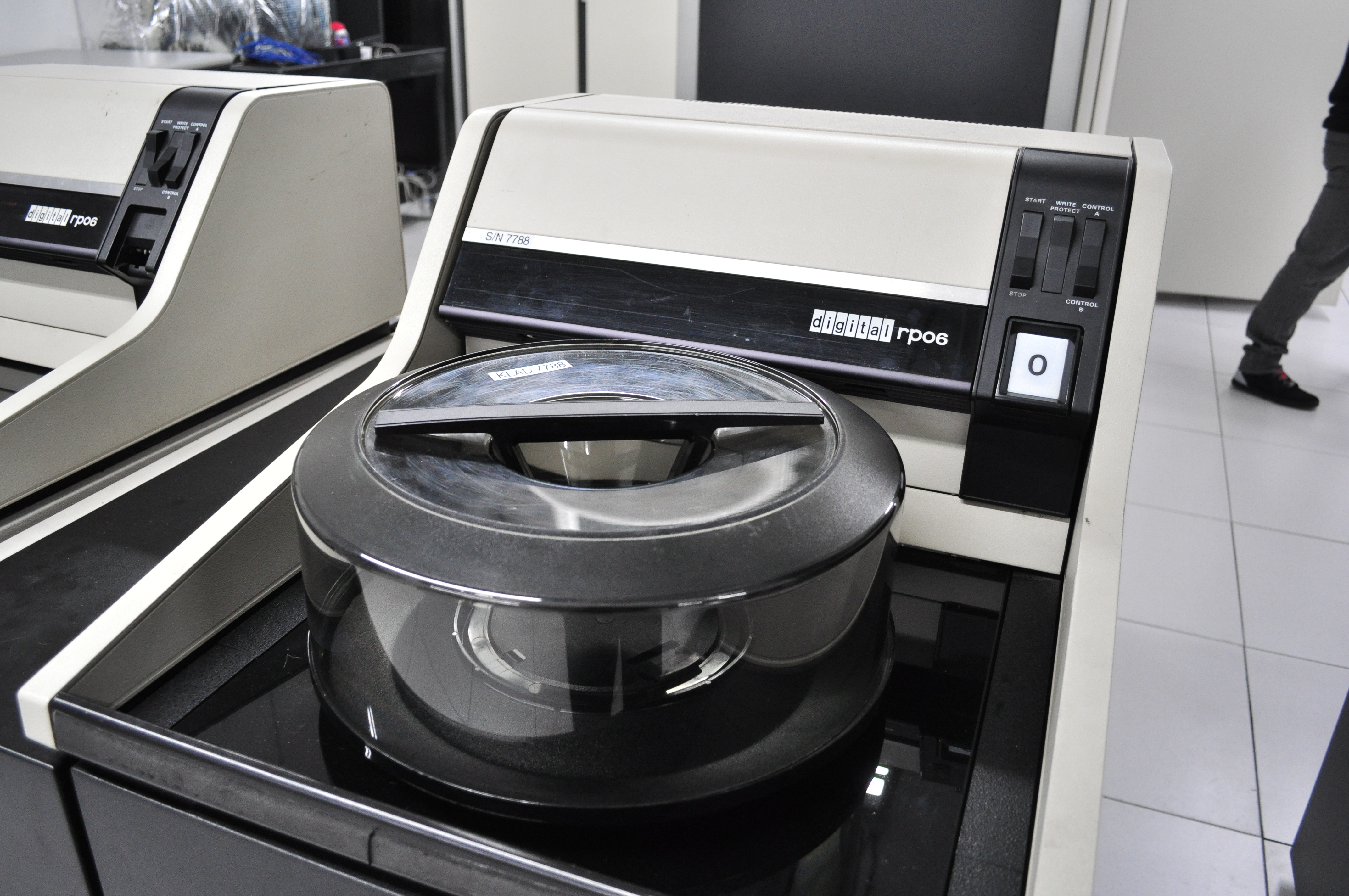|
VAX 8000
The VAX 8000 is a discontinued family of superminicomputers developed and manufactured by Digital Equipment Corporation (DEC) using processors implementing the VAX instruction set architecture (ISA). The 8000 series was introduced in October 1984 with the 8600, taking over the high-end of the VAX lineup. Originally known as the 11/790, it offers performance roughly double that of the earlier 11/780. It was succeeded by the 8650 (formerly the 11/795) in December 1985. January 1986 saw the introduction of the 8200 and 8300 families in the mid-range. The 8800 replaced the 8600s at the high end in 1987, with the 8700 and 8500 being lower-performance versions of these systems. DEC also offered various clusters of these machines with a variety of model numbers. As with other VAX systems, they were sold with either the VMS or Ultrix operating systems. It was intended that the 8800 was to have been replaced by the VAX 9000 on the high end, but the VAX 6000, originally a mid-range model ... [...More Info...] [...Related Items...] OR: [Wikipedia] [Google] [Baidu] |
VAX Console
VAX (an acronym for Virtual Address eXtension) is a series of computers featuring a 32-bit instruction set architecture (ISA) and virtual memory that was developed and sold by Digital Equipment Corporation (DEC) in the late 20th century. The VAX-11/780, introduced October 25, 1977, was the first of a range of popular and influential computers implementing the VAX ISA. The VAX family was a huge success for DEC – over 100 models were introduced over the lifetime of the design, with the last members arriving in the early 1990s. The VAX was succeeded by the DEC Alpha, which included several features from VAX machines to make porting from the VAX easier. VAX was designed as a successor to the 16-bit PDP-11, one of the most successful minicomputers in history with approximately 600,000 examples sold. The system was designed to offer backward compatibility with the PDP-11 while extending the memory to a full 32-bit implementation and adding demand paged virtual memory. The name ... [...More Info...] [...Related Items...] OR: [Wikipedia] [Google] [Baidu] |
Bipolar Junction Transistor
A bipolar junction transistor (BJT) is a type of transistor that uses both electrons and electron holes as charge carriers. In contrast, a unipolar transistor, such as a field-effect transistor, uses only one kind of charge carrier. A bipolar transistor allows a small current injected at one of its terminals to control a much larger current flowing between the terminals, making the device capable of amplification or switching. BJTs use two p–n junctions between two semiconductor types, n-type and p-type, which are regions in a single crystal of material. The junctions can be made in several different ways, such as changing the doping of the semiconductor material as it is grown, by depositing metal pellets to form alloy junctions, or by such methods as diffusion of n-type and p-type doping substances into the crystal. The superior predictability and performance of junction transistors quickly displaced the original point-contact transistor. Diffused transistors, along wi ... [...More Info...] [...Related Items...] OR: [Wikipedia] [Google] [Baidu] |
VAXBI
The VAXBI bus (VAX Bus Interconnect bus) is a computer bus designed and sold by the Digital Equipment Corporation (DEC) of Maynard, Massachusetts. The bus is an advanced, configuration-free synchronous bus used on DEC's later VAX computers. Like the Unibus and Q-Bus before it, it uses memory-mapped I/O but has 32-bit address and data paths. The VAXBI is a multiplexed bus with fully distributed arbitration and geographic addressing. All of the logic required to implement a VAXBI interface is contained within a single custom integrated circuit (the "BIIC") and the physical layout and printed wiring board layout for compliant cards is tightly specified, right down to the location of the dual amber status LEDs that are required. The portion of the card that is reserved for the bus interface is referred to as "the VAXBI corner". VAXBI licensees were given the appropriate engineering drawings to allow them to exactly replicate a compliant card. VAXBI cards mount into backplanes us ... [...More Info...] [...Related Items...] OR: [Wikipedia] [Google] [Baidu] |
V-11
The V-11, code-named "Scorpio", is a miniprocessor chip set implementation of the VAX instruction set architecture (ISA) developed and fabricated by Digital Equipment Corporation (DEC). History The V-11 was Digital's first VAX microprocessor design, but was the second to ship, after the MicroVAX 78032. It was presented at the 39th International Solid State Circuits Conference held in 1984 alongside the MicroVAX 78032 and was introduced in early 1986 in systems, operating at 5 MHz (200 ns cycle time) and in 1987 at 6.25 MHz (160 ns cycle time). The V-11 was proprietary to DEC and was only used in their VAX 8200, VAX 8250, VAX 8300 and VAX 8350 minicomputers; and the VAXstation 8000 workstation. At 5 MHz, the V-11 performed approximately the same as the VAX-11/780 superminicomputer. At 6.25 MHz, it performed approximately 1.2 times faster than the VAX-11/780. The V-11 was part of the Scorpio program, which aimed at providing DEC with the ability to develop an ... [...More Info...] [...Related Items...] OR: [Wikipedia] [Google] [Baidu] |
Multiprocessor
Multiprocessing is the use of two or more central processing units (CPUs) within a single computer system. The term also refers to the ability of a system to support more than one processor or the ability to allocate tasks between them. There are many variations on this basic theme, and the definition of multiprocessing can vary with context, mostly as a function of how CPUs are defined ( multiple cores on one die, multiple dies in one package, multiple packages in one system unit, etc.). According to some on-line dictionaries, a multiprocessor is a computer system having two or more processing units (multiple processors) each sharing main memory and peripherals, in order to simultaneously process programs. A 2009 textbook defined multiprocessor system similarly, but noting that the processors may share "some or all of the system’s memory and I/O facilities"; it also gave tightly coupled system as a synonymous term. At the operating system level, ''multiprocessing'' is som ... [...More Info...] [...Related Items...] OR: [Wikipedia] [Google] [Baidu] |
System Console
One meaning of system console, computer console, root console, computer operator, operator's console, or simply console is the text entry and display device for system administration messages, particularly those from the BIOS or boot loader, the Kernel (computer science), kernel, from the init system and from the syslog, system logger. It is a physical device consisting of a keyboard and a screen, and traditionally is a text terminal, but may also be a graphical terminal. System consoles are generalized to computer terminals, which are abstracted respectively by virtual consoles and terminal emulators. Today communication with system consoles is generally done abstractly, via the standard streams (stdin, stdout, and stderr), but there may be system-specific interfaces, for example those used by the system kernel. Another, older, meaning of system console, computer console, hardware console, operator's console or simply console is a hardware component used by an operator to control ... [...More Info...] [...Related Items...] OR: [Wikipedia] [Google] [Baidu] |
PDP-11
The PDP-11 is a series of 16-bit minicomputers sold by Digital Equipment Corporation (DEC) from 1970 into the 1990s, one of a set of products in the Programmed Data Processor (PDP) series. In total, around 600,000 PDP-11s of all models were sold, making it one of DEC's most successful product lines. The PDP-11 is considered by some experts to be the most popular minicomputer. The PDP-11 included a number of innovative features in its instruction set and additional general-purpose registers that made it much easier to program than earlier models in the PDP series. Further, the innovative Unibus system allowed external devices to be easily interfaced to the system using direct memory access, opening the system to a wide variety of peripherals. The PDP-11 replaced the PDP-8 in many real-time computing applications, although both product lines lived in parallel for more than 10 years. The ease of programming of the PDP-11 made it very popular for general-purpose computing uses also. ... [...More Info...] [...Related Items...] OR: [Wikipedia] [Google] [Baidu] |
Massbus
The Massbus is a high-performance computer input/output bus designed in the 1970s by Digital Equipment Corporation (DEC). The architecture development was sponsored by Gordon Bell and John Levy was the principal architect. The bus was used by Digital to interconnect its highest-performance computers with magnetic disk and magnetic tape storage equipment. The use of a common bus was intended to allow a single controller design to handle multiple peripheral models, and allowed the PDP-10, PDP-11, and VAX computer families to share a common set of peripherals. At the time there were multiple operating systems for each of the 16-bit, 32-bit, and 36-bit computer lines. The 18-bit PDP-15/40 connected to Massbus peripherals via a PDP-11 front end. An engineering goal was to reduce the need for a new driver per peripheral per operating system per computer family. Also, a major technical goal was to place any magnetic technology changes (data separators) into the storage device rather th ... [...More Info...] [...Related Items...] OR: [Wikipedia] [Google] [Baidu] |
Unibus
The Unibus was the earliest of several computer bus and backplane designs used with PDP-11 and early VAX systems manufactured by the Digital Equipment Corporation (DEC) of Maynard, Massachusetts. The Unibus was developed around 1969 by Gordon Bell and student Harold McFarland while at Carnegie Mellon University. The name refers to the unified nature of the bus; Unibus was used both as a system bus allowing the central processing unit to communicate with main memory, as well as a peripheral bus, allowing peripherals to send and receive data. Unifying these formerly separate busses allowed external devices to easily perform direct memory access (DMA) and made the construction of device drivers easier as control and data exchange was all handled through memory-mapped I/O. Unibus was physically large, which led to the introduction of Q-bus, which multiplexed some signals to reduce pin count. Higher performance PDP systems used Fastbus, essentially two Unibusses in one. The syst ... [...More Info...] [...Related Items...] OR: [Wikipedia] [Google] [Baidu] |
Synchronous Backplane Interconnect
The Synchronous Backplane Interconnect (SBI) was the internal processor-memory bus used by early VAX computers manufactured by the Digital Equipment Corporation of Maynard, Massachusetts. The bus was implemented using Schottky TTL logic levels and allowed multiprocessor Multiprocessing is the use of two or more central processing units (CPUs) within a single computer system. The term also refers to the ability of a system to support more than one processor or the ability to allocate tasks between them. There ar ... operation. Computer buses DEC hardware {{Compu-hardware-stub ... [...More Info...] [...Related Items...] OR: [Wikipedia] [Google] [Baidu] |
Metal Oxide Semiconductor
The metal–oxide–semiconductor field-effect transistor (MOSFET, MOS-FET, or MOS FET) is a type of field-effect transistor (FET), most commonly fabricated by the controlled oxidation of silicon. It has an insulated gate, the voltage of which determines the conductivity of the device. This ability to change conductivity with the amount of applied voltage can be used for amplifying or switching electronic signals. A metal-insulator-semiconductor field-effect transistor (MISFET) is a term almost synonymous with MOSFET. Another synonym is IGFET for insulated-gate field-effect transistor. The basic principle of the field-effect transistor was first patented by Julius Edgar Lilienfeld in 1925.Lilienfeld, Julius Edgar (1926-10-08) "Method and apparatus for controlling electric currents" upright=1.6, Two power MOSFETs in V_in_the_''off''_state,_and_can_conduct_a_continuous_current_of_30 surface-mount_packages._Operating_as_switches,_each_of_these_components_can_su ... [...More Info...] [...Related Items...] OR: [Wikipedia] [Google] [Baidu] |


.jpg)

